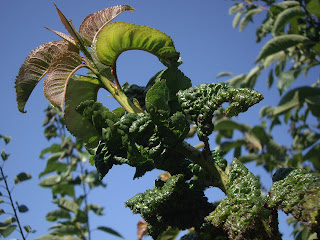- Lots of fertilizer - even more than usual this year, excess of 100 lbs of total Nitrogen per acre applied multiple times since spring
- Early thinning - blossom removal and whole clusters, hand thinning when apples were very small (size of fingernail)
- Something different this year was a later chemical thinning application of lime sulphur and fish oil - First application was at full bloom and second application was at post bloom. The idea was that the king bloom should have been well set before putting out the chemical thinner. Based on the size of most of our Galas, this was achieved. Bill cannot explain why they are typier (longer) but its also a good attribute.
Here are the Reds at Last Chance that we grafted to Honeycrisp last spring. They are growing really well and just recently received some training.
One shoot from each graft is bundled together on each leader of the tree with electrical tape. There were 2-4 grafts on each leader depending upon the size of the leader. The workers chose the shoots with the best angle of limb. This winter they will remove everything that is not wrapped. Next year the growth will be amazing. We expect a good crop on year four/2014.
We have some grafted Honeycrisp trees producing fruit at Last Chance as well. Grafted Honeycrisp trees can grow some really ugly fruit to begin with because they tend to be overvigorous (the engine is too big for the amount of fruit produced). This apple is showing bitterpit which makes it a cull.
Here is an example of sunburn. We've had about 4-5 days of unseasonably hot weather. As a result, we'll have some sunburn damage. Every year we have a certain amount of sunburn damage. Usually we have our hottest weather in July and August. This year we didn't have the heat until now. Since it's so late in the summer now, the hot temps only last a few hours of the day.We apply protective sprays to minimize the sun damage on our most valuable crops.
Here is a picture of a cherry limb with aphids. Can you see the ladybugs? They are dining on the nasty aphids. Apparently not fast enough! We have more aphids than we like right now. Oil is really good at snuffing out aphids when they first appear. Bill is planning on 2 applications of oil, either one this fall and one in the spring or two in the spring. The problem with a fall application is that the coverage isn't as good with the leaves. In the spring, there are no leaves when oil is applied. Last year we did not apply an oil in the fall and only applied one application in the spring.
New growth has emerged through the aphid attack. The ladybugs earned their keep here!
Here are some ladybug pupae. Yes, we bought gallons ($50/gal) of ladybugs this summer to organically conquer the aphids.
Here is a ladybug larva.










No comments:
Post a Comment